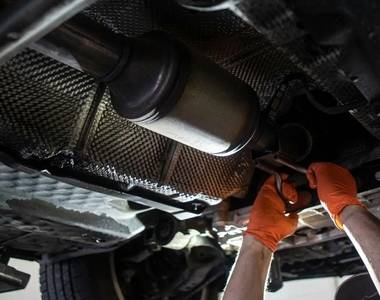Whether you’re getting insurance quotes, arranging finance or just shopping for a new headlight bulb, knowing how the age of a car is essential information. Reg years is one way to find out 'what year is my car' but there are other ways too.
So, how can you find out your car’s year?
The truth is, there’s a handful of different methods you can use for identifying the year your car was made or registered – and as a driver, it’s useful to know at least one way of working it out.
Here, we’ll explain each way – so you’ve got all the information you need next time you’re asked.
Registration year vs manufacturer year
It’s useful to know that the ‘registration year’ and ‘manufacture year’ are sometimes different – even if they appear to be the same thing.
Sound confusing?
Don’t worry – it’s fairly simple, and all boils down to how cars are sold.
Let’s say you buy a new Volkswagen Golf. The vehicle will be manufactured in Wolfsburg in Germany – then it’ll make its way to the UK before being registered by the dealer you’ve bought it from. There could be a number of weeks (or even months) between the car leaving the production line and being registered by the dealer – so the dates can be quite different.
So, let's say the car left the factory in December 2019 – but didn’t get to the dealer until January 2020. The registration year will be 2020 – but the manufacture year will be 2019.
Both these dates are useful to know – so this list will include ways of finding out both.
How do you find out the year of your car?
With information that most drivers can easily access, there are 5 different ways to check how old your car is.
In this guide, we’ll outline the quickest and simplest ways first – but we’ll cover all 5 methods, so you’re never stuck wondering “How old is my car?”
1. Use our free online car valuation service to see your car registration year
Whether you’re buying, selling, part-exchanging, or even scrapping – we’ve got all the information you need to work out what your car is worth.
The good news is, a big part of what any vehicle is worth is how old it is – so if you get a valuation for your car using our free service, the information you get in return will also tell you the year it was made.
Don’t worry – just because you’ve got a valuation, you’re not committing to selling your car! You’ll simply get a range of prices that explain how much it’s worth – so if you’re wondering “When was my car registered?” – this is a quick way of getting an answer!
2. Enter your registration to get a free MOT check and registration date
Since vehicles need to have an MOT carried out 3 years after they are first registered, our free MOT check service gives you the car’s first registration date, along with its next MOT date.
Again, this is just quick way to check your registration date quickly and completely free of charge.
The added bonus of using the MOT check service is that you’ll get a detailed history of all the tests that have been carried out on the car in the past – and you’ll even be able to schedule MOT reminders that let you know when your next test is coming up.
3. Understand how number plate years work
Although they might just look like a string of random letters and numbers – a vehicle’s number plate is actually a great way of working out different car registration years.
We’ve put together a UK car registration years chart that’ll help you work out what year your car reg relates to:
Millennium registrations (Current Series)
As the name suggests, Millennium registrations were issued from 2001 onwards and follow 2 letter, 2 number, 3 letter format.
For example: AB51 ABC or AB02 ABC
In this format, the numbers indicate the vehicle’s year of registration. Number plates in this format are issued every 6 months – in March and September.

Table showing the age identifier used by current registrations:
|
Plate |
From |
To |
|---|---|---|
|
51 plate year |
September 2001 |
March 2002 |
|
02 plate year |
March 2002 |
September 2002 |
|
52 plate year |
September 2002 |
March 2003 |
|
03 plate year |
March 2003 |
September 2003 |
|
53 plate year |
September 2003 |
March 2004 |
|
04 plate year |
March 2004 |
September 2004 |
|
54 plate year |
September 2004 |
March 2005 |
|
05 plate year |
March 2005 |
September 2005 |
|
55 plate year |
September 2005 |
March 2006 |
|
06 plate year |
March 2006 |
September 2006 |
|
56 plate year |
September 2006 |
March 2007 |
|
07 plate year |
March 2007 |
September 2007 |
|
57 plate year |
September 2007 |
March 2008 |
|
08 plate year |
March 2008 |
September 2008 |
|
58 plate year |
September 2008 |
March 2009 |
|
09 plate year |
March 2009 |
September 2009 |
|
59 plate year |
September 2009 |
March 2010 |
|
10 plate year |
March 2010 |
September 2010 |
|
60 plate year |
September 2010 |
March 2011 |
|
11 plate year |
March 2011 |
September 2011 |
|
61 plate year |
September 2011 |
March 2012 |
|
12 plate year |
March 2012 |
September 2012 |
|
62 plate year |
September 2012 |
March 2013 |
|
13 plate year |
March 2013 |
September 2013 |
|
63 plate year |
September 2013 |
March 2014 |
|
14 plate year |
March 2014 |
September 2014 |
|
64 plate year |
September 2014 |
March 2015 |
|
15 plate year |
March 2015 |
September 2015 |
|
65 plate year |
September 2015 |
March 2016 |
|
16 plate year |
March 2016 |
September 2016 |
|
66 plate year |
September 2016 |
March 2017 |
|
17 plate year |
March 2017 |
September 2017 |
|
67 plate year |
September 2017 |
March 2018 |
|
18 plate year |
March 2018 |
September 2018 |
|
68 plate year |
September 2018 |
March 2019 |
|
19 plate year |
March 2019 |
September 2019 |
|
69 plate year |
September 2019 |
March 2020 |
|
20 plate year |
March 2020 |
September 2020 |
|
70 plate year |
September 2020 |
March 2021 |
|
21 plate year |
March 2021 |
September 2021 |
This system is due to continue in the format until the end of 2049 – at which point the government will decide on the next format for vehicle registrations.
Prefix registrations
Before Millennium registrations, the number plate system was referred to as ‘Prefix registrations’. These registrations ran between 1983 and 2001 and followed a 1 letter, 1, 2, or 3 numbers, then 3 letters.
For example: A234 ABC or A1 ABC
In this format, the letter at the beginning of the registration mark indicates the year that the car was first registered.
You’ll notice that the letters I, O, Q, U, and Z are not used as prefixes. It was decided that I, O, and Z look too much like numbers, and U looked too similar to V. Q plates are used – but they’re reserved for vehicles with an age that cannot be determined – some kit cars and imports for instance. Many people are often looking for what alphabetical number represents which reg year, please refer to our handy table below. The last reg years plate was the Y Reg Year in 2001.
|
Prefix |
From |
To |
|---|---|---|
|
A reg year |
August 1983 |
July 1984 |
|
B reg year |
August 1984 |
July 1985 |
|
C reg year |
August 1985 |
July 1986 |
|
D reg year |
August 1986 |
July 1987 |
|
E reg year |
August 1987 |
July 1988 |
|
F reg year |
August 1988 |
July 1989 |
|
G reg year |
August 1989 |
July 1990 |
|
H reg year |
August 1990 |
July 1991 |
|
J reg year |
August 1991 |
July 1992 |
|
K reg year |
August 1992 |
July 1993 |
|
L reg year |
August 1993 |
July 1994 |
|
M reg year |
August 1994 |
July 1995 |
|
N reg year |
August 1995 |
July 1996 |
|
P reg year |
August 1996 |
July 1997 |
|
R reg year |
August 1997 |
July 1998 |
|
S reg year |
August 1998 |
February 1999 |
|
T reg year |
March 1999 |
July 1999 |
|
V reg year |
August 1999 |
February 2000 |
|
W reg year |
March 2000 |
July 2000 |
|
X reg year |
August 2000 |
February 2001 |
|
Y reg year |
March 2001 |
July 2001 |
Suffix registrations
If we wind the clock back to before 1983, ‘Suffix registrations’ were used on number plates. These are rare now – but they do crop up on classic vehicles and as personalised registrations. These registrations ran between 1963 and 1983 and consisted of 3 letters, 1, 2, or 3 numbers, then 1 letter.
For example: ABC 1A or DEF 123B
In this format, the final letter of the registration indicates the age – but again, like prefix registrations, I, O, Q, U, and Z are not used.
|
Suffix |
From |
To |
|---|---|---|
|
old A reg year |
start of 1963 |
end of 1963 |
|
old B reg year |
start of 1964 |
end of 1964 |
|
old C reg year |
start of 1965 |
end of 1965 |
|
old D reg year |
start of 1966 |
end of 1966 |
|
old E reg year |
January 1967 |
July 1967 |
|
old F reg year |
August 1967 |
July 1968 |
|
old G reg year |
August 1968 |
July 1969 |
|
old H reg year |
August 1969 |
July 1970 |
|
old J reg year |
August 1970 |
July 1971 |
|
old K reg year |
August 1971 |
July 1972 |
|
old L reg year |
August 1972 |
July 1973 |
|
old M reg year |
August 1973 |
July 1974 |
|
old N reg year |
August 1974 |
July 1975 |
|
old P reg year |
August 1975 |
July 1976 |
|
old R reg year |
August 1976 |
July 1977 |
|
old S reg year |
August 1977 |
July 1978 |
|
old T reg year |
August 1978 |
July 1979 |
|
old V reg year |
August 1979 |
July 1980 |
|
old W reg year |
August 1980 |
July 1981 |
|
old X reg year |
August 1981 |
July 1982 |
|
old Y reg year |
August 1982 |
July 1983 |
4. Check the V5 registration document
If you’re still wondering “When was my car registered” but decide against online checks and or decoding your number plate – then it’s time to dig out your vehicle paperwork!
You’re looking for your V5C certificate – the form issued by the DVLA to show who is responsible for registering and taxing a vehicle. This document’s often known as a log book – but don’t let the name fool you; it isn’t a book – it’s a 4-sided multi-coloured form that’s used to update the DVLA if anything relating to the vehicle changes.
The V5C has a section entitled ‘Vehicle Details’ – showing everything from the engine capacity and fuel type to the colour and weight of the car. This section also includes the full vehicle registration date.
5. Use the Vehicle Identification Number (VIN)
Finally, there’s the option to use the VIN (vehicle identification number) to give a good indication of when the car was made.
You can locate the VIN on the log book – in the same ‘vehicle details’ section as you’ll find the registration date – or by locating the VIN plate on the car.
On most vehicles sold in the UK, the VIN plate is normally found in a clear section of the glass at the bottom of the windscreen – although it’s sometimes stamped on a metal plate that’s found in the engine bay or around one of the sections of body visible when the driver door is open.
When you’ve found the 17-digit VIN, you’ll have to locate the 10th character. This is a universal code used by manufacturers to indicate when the model was last revised – and since models are usually tweaked from year-to-year (even if it’s just minor trim changes or optional colours), this character will almost always give the date that the car was manufactured.
Since there is only one character that can be used to indicate this year, it cycles through letters and numbers since VINs were introduced in 1980.
|
Code |
Year |
Code |
Year |
Code |
Year |
|---|---|---|---|---|---|
|
A |
1980 |
R |
1994 |
8 |
2008 |
|
B |
1981 |
S |
1995 |
9 |
2009 |
|
C |
1982 |
T |
1996 |
A |
2010 |
|
D |
1983 |
V |
1997 |
B |
2011 |
|
E |
1984 |
W |
1998 |
C |
2012 |
|
F |
1985 |
X |
1999 |
D |
2013 |
|
G |
1986 |
Y |
2000 |
E |
2014 |
|
H |
1987 |
1 |
2001 |
F |
2015 |
|
J |
1988 |
2 |
2002 |
G |
2016 |
|
K |
1989 |
3 |
2003 |
H |
2017 |
|
L |
1990 |
4 |
2004 |
J |
2018 |
|
M |
1991 |
5 |
2005 |
K |
2019 |
|
N |
1992 |
6 |
2006 |
L |
2020 |
|
P |
1993 |
7 |
2007 |
M |
2021 |
If you’re keen to answer the question “What year was my car made?” rather than simply when it was registered – then exploring the VIN number codes is the best way to find out. Since this 10th character relates to the year in which the model was last revised, it won’t always be correct (although it generally is), so if you’re unsure, speaking to the original dealer that supplied that car will confirm the year of manufacture 100%.
Where was my car registered?
Finally, if you’re hoping to find out where in the country your car was originally registered, it is possible to decipher this information from your number plate.
For Millennium registrations, this information comes from the 2 letters at the beginning of the number plate.
|
Regional Identifiers |
Region |
DVLA Office |
|---|---|---|
|
AA, AB, AC, AD, AE, AF, AG, AH, AJ, AK, AL, AM, AN |
Anglia |
Peterborough |
|
AO, AP, AR, AS, AT, AU |
Anglia |
Norwich |
|
AV, AW, AX, AY |
Anglia |
Ipswich |
|
BA, BB, BC, BD, BE, BF, BG, BH, BJ, BK, BL, BM, BN, BO, BP, BR, BS, BT, BU, BV, BW, BX, BY |
Birmingham |
Birmingham |
|
CA, CB, CC, CD, CE, CF, CG, CH, CJ, CK, CL, CM, CN, CO |
Cymru |
Cardiff |
|
CP, CR, CS, CT, CU, CV |
Cymru |
Swansea |
|
CW, CX, CY |
Cymru |
Bangor |
|
DA, DB, DC, DD, DE, DF, DG, DH, DJ, DK |
Deeside to Shrewsbury |
Chester |
|
DL, DM, DN, DO, DP, DR, DS, DT, DU, DV, DW, DX, DY |
Deeside to Shrewsbury |
Shrewsbury |
|
EA, EB, EC, ED, EE, EF, EG, EH, EJ, EK, EL, EM, EN, EO, EP, ER, ES, ET, EU, EV, EW, EX, EY |
Essex |
Chelmsford |
|
FA, FB, FC, FD, FE, FF, FG, FH, FJ, FK, FL, FM, FN, FP |
Forest and Fens |
Nottingham |
|
FR, FS, FT, FV, FW, FX, FY |
Forest and Fens |
Lincoln |
|
GA, GB, GC, GD, GE, GF, GG, GH, GJ, GK, GL, GM, GN, GO |
Garden of England |
Maidstone |
|
GP, GR, GS, GT, GU, GV, GX, GY |
Garden of England |
Brighton |
|
HA, HB, HC, HD, HE, HF, HG, HH, HJ |
Hampshire and Dorset |
Bournemouth |
|
HK, HL, HM, HN, HO, HP, HR, HS, HT, HU, HV, HX, HY |
Hampshire and Dorset |
Portsmouth |
|
HW |
Hampshire and Dorset |
Portsmouth (Used exclusively for the Isle of Wight) |
|
KA, KB, KC, KD, KE, KF, KG, KH, KJ, KK, KL |
- |
Luton |
|
KM, KN, KO, KP, KR, KS, KT, KU, KV, KW, KX, KY |
- |
Northampton |
|
LA, LB, LC, LD, LE, LF, LG, LH, LJ |
London |
Wimbledon |
|
LK, LL, LM, LN, LO, LP, LR, LS, LT |
London |
Stanmore |
|
LU, LV, LW, LX, LY |
London |
Sidcup |
|
MA, MB, MC, MD, ME, MF, MG, MH, MJ, MK, ML, MM, MN, MO, MP, MR, MS, MT, MU, MV, MW, MX, MY |
Manchester and Merseyside |
Manchester |
|
NA, NB, NC, ND, NE, NF, NG, NH, NJ, NK, NL, NM, NN, NO |
North |
Newcastle |
|
NP, NR, NS, NT, NU, NV, NW, NX, NY |
North |
Stockton |
|
OA, OB, OC, OD, OE, OF, OG, OH, OJ, OK, OL, OM, ON, OO, OP, OR, OS, OT, OU, OV, OW, OX, OY |
Oxford |
Oxford |
|
PA, PB, PC, PD, PE, PF, PG, PH, PJ, PK, PL, PM, PN, PO, PP, PR, PS, PT |
Preston |
Preston |
|
PU, PV, PW, PX, PY |
Preston |
Carlisle |
|
RA, RB, RC, RD, RE, RF, RG, RH, RJ, RK, RL, RM, RN, RO, RP, RR, RS, RT, RU, RV, RW, RX, RY |
Reading |
Reading |
|
SA, SB, SC, SD, SE, SF, SG, SH, SJ |
Scotland |
Glasgow |
|
SK, SL, SM, SN, SO |
Scotland |
Edinburgh |
|
SP, SR, SS, ST |
Scotland |
Dundee |
|
SU, SV, SW |
Scotland |
Aberdeen |
|
SX, SY |
Scotland |
Inverness |
|
VA, VB, VC, VD, VE, VF, VG, VH, VJ, VK, VL, VM, VN, VO, VP, VR, VS, VT, VU, VV, VW, VX, VY |
Severn Valley |
Worcester |
|
WA, WB, WC, WD, WE, WF, WG, WH, WJ |
West of England |
Exeter |
|
WK, WL |
West of England |
Truro |
|
WM, WN, WO, WP, WR, WS, WT, WU, WV, WW, WX, WY |
West of England |
Bristol |
|
YA, YB, YC, YD, YE, YF, YG, YH, YJ, YK |
Yorkshire |
Leeds |
|
YL, YM, YN, YO, YP, YR, YS, YT, YU |
Yorkshire |
Sheffield |
|
YV, YW, YX, YY |
Yorkshire |
Beverley |











